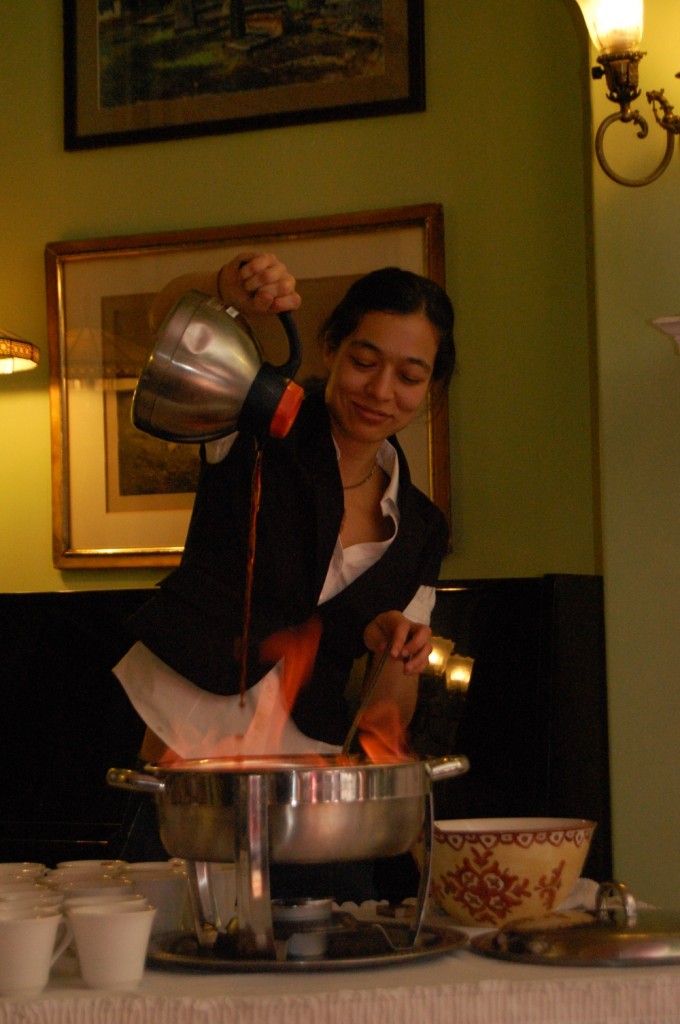DC Mixologists Chantal Tseng and Adam Bernbach offer up some simmering sips to cure what ails ya.
By Kelly A. Magyarics
Crackling fireplace? Check. Sumptuous sofas? Check. Low lit rooms dotted with flickering candles? Check. Sure, the Tabard Inn (1739 N Street NW, 202.331.8528, tabardinn.com) in January is always conducive to sipping a winter warmer…or three. And with two of the District’s hottest mixologists in tow, teaching one in a series of seasonal seminars about steaming libations, it was a veritable wonder I was able to drag myself back out into the cold.
So what makes a good hot drink? According to Chantal Tseng, resident mixologist at the historic inn, restaurant and bar near Dupont Circle, it “should pay homage to its heritage, when people were looking to keep their blood flowing with spice, cure their coughs with citrus, soothe their throats with honey and hot water and of course ease their worries with spirit.” Basically, this magical mixture of hot water (or perhaps coffee or tea), citrus, sweetener, spices and booze is part medicinal elixir, part pick-me-up, and part internal hot water bottle. Tseng, along with Adam Bernbach, Bar Manager for Proof and Estadio, recently concocted a few clever and warming variations on the theme for willing, chilly guests.
While Tseng was ladling liquid into mugs garnished with lemon peels and cinnamon sticks, I asked her just how warm this style of cocktail should be served. She told me that it often depends on personal preference, though ingredients also come into play. If there is a high proof spirit in the beverage, then the steam present in a super hot drink will act as a conduit, delivering the alcohol burn right up your nose—not very appealing. But on the flip side, a tepid tipple is equally far from soothing. My verdict? Err on the warmer side—the imbiber can always let the heat from the mug warm their hands while waiting to take that first sip.
To kickstart the evening, Bernbach served up a warm punch with genever as its base. This precursor to gin is earthy and malty, and works well with the included spices. He uses unpeeled ginger in the mulled mixture to add additional bite. If you don’t like it that kicky, peel the ginger, use a smaller piece, or steep for a shorter amount of time. I love ginger, so this drink was right up my alley.
Lil’ One Genever Punch
Courtesy of Adam Bernbach, Bar Manager at Proof and Estadio, Washington, DC
Makes 4 drinks
For the mulled spice mixture:
24 oz. water
Thumb-sized piece of unpeeled ginger, finely chopped
1 star anise pod
1 cinnamon stick
½ to 2/3 of a lemon
Pour water into saucepan. Add ginger, star anise, cinnamon and lemon. Bring to a boil, remove from the heat, and steep until flavor is desired. Strain out solids.
For each drink: Pour 1.5 oz. Bols Genever into a mug. Add 6 oz. of mulled spice mixture. Stir, and garnish with a lemon peel.
If you like the spice and citrus in a Hot Toddy, but are more of a coffee drinker than a tea sipper, then you may want to tackle a batch of flambéed Café Brulôt. Invented at New Orleans restaurant Antoine’s in the 1890s, this coffee- and chickory-based drink also happened to be a convenient way for imbibers to disguise their alcohol during Prohibition. Tseng and Bernbach were inspired after a trip to the Big Easy to whip up their own batches of the fragrant java. They prefer to use Rémy Martin 1738 Brandy, and Cointreau Noir Liqueur–that company’s answer to Grand Marnier (I prefer the Cointreau version as well.) What makes the drink visually striking (besides the orange flames, of course,) are the long, clove-studded orange and lemon peels. This is definitely the parlor trick to try to impress your dinner guests during the dessert course. The Tabard Inn served up some amazing sugarcoated beignets and whipped cream alongside the tricked out coffee. Definitely a sweet ending to a perfect January evening.
Café Brulôt
Courtesy of Chantal Tseng, The Tabard Inn, Washington, DC
1 stick cinnamon
4 cloves
4 curls of orange peel
4 curls of lemon peel
2 teaspoons dark brown sugar
2 oz. Remy Martin 1738 brandy
1 oz. Cointreau Noir
Strong brewed coffee (with or without chickory)
Simmer all the above except the brewed coffee in a fireproof bowl (a fondue pot also works well). Light with a match. Lift up the lemon and orange peels with tongs, and use a ladle to stir and pour the liquid onto the peels for several minutes. Pour the hot coffee into the flaming brandy mixture to extinguish the flame, and ladle the mixture into coffee cups.
Kelly Magyarics is a wine and spirits writer, and wine educator, in the Washington, DC area. She can be reached through her website, www.kellymagyarics.com, or on www.twitter.com/kmagyarics.



